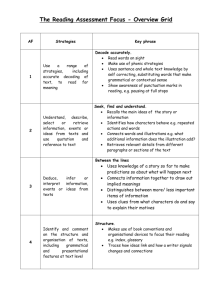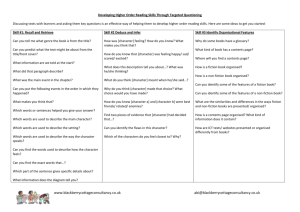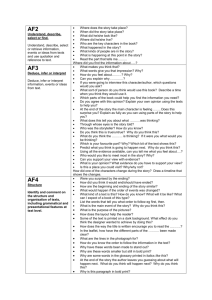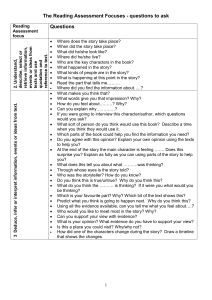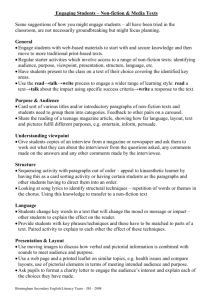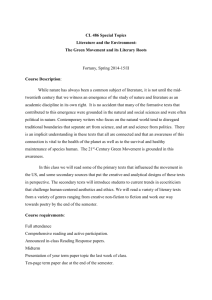Questions to develop Reading Comprehension
advertisement
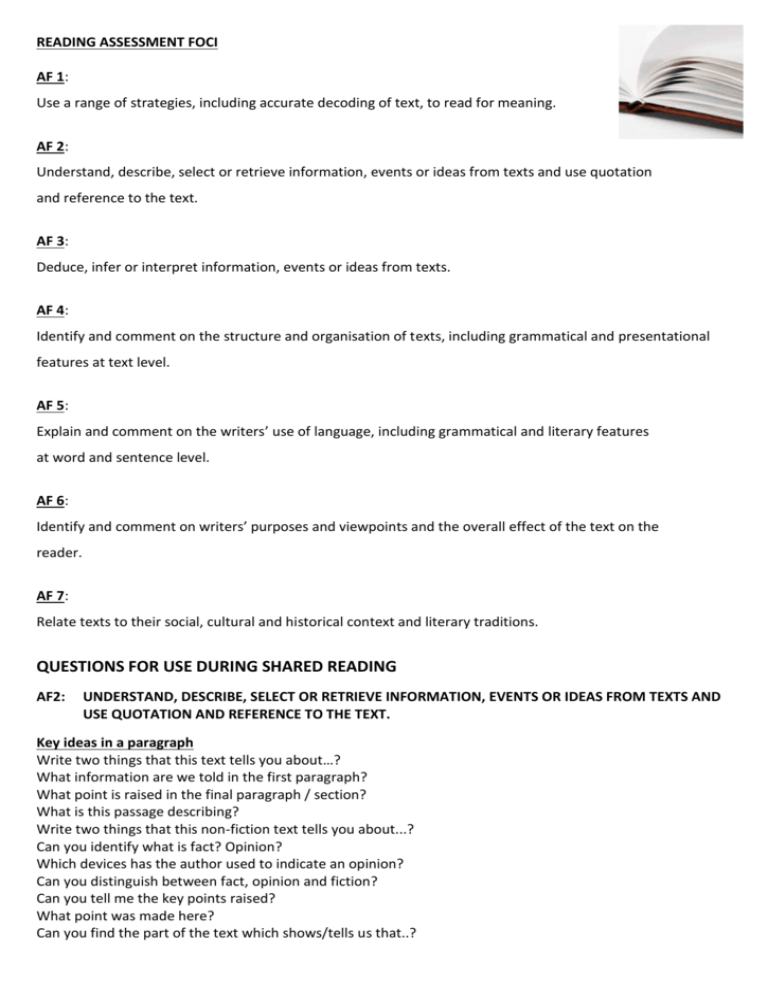
READING ASSESSMENT FOCI AF 1: Use a range of strategies, including accurate decoding of text, to read for meaning. AF 2: Understand, describe, select or retrieve information, events or ideas from texts and use quotation and reference to the text. AF 3: Deduce, infer or interpret information, events or ideas from texts. AF 4: Identify and comment on the structure and organisation of texts, including grammatical and presentational features at text level. AF 5: Explain and comment on the writers’ use of language, including grammatical and literary features at word and sentence level. AF 6: Identify and comment on writers’ purposes and viewpoints and the overall effect of the text on the reader. AF 7: Relate texts to their social, cultural and historical context and literary traditions. QUESTIONS FOR USE DURING SHARED READING AF2: UNDERSTAND, DESCRIBE, SELECT OR RETRIEVE INFORMATION, EVENTS OR IDEAS FROM TEXTS AND USE QUOTATION AND REFERENCE TO THE TEXT. Key ideas in a paragraph Write two things that this text tells you about…? What information are we told in the first paragraph? What point is raised in the final paragraph / section? What is this passage describing? Write two things that this non-fiction text tells you about...? Can you identify what is fact? Opinion? Which devices has the author used to indicate an opinion? Can you distinguish between fact, opinion and fiction? Can you tell me the key points raised? What point was made here? Can you find the part of the text which shows/tells us that..? On what page could I find information about..? How is this page set out? Title What is the title of this story? Can you suggest an alternative title? Why do you think the author used this title for the text? Can you predict what the text might be about from the title? Can you predict the genre of this book from the title? Setting Where did they go on holiday? Which word is used to describe the…? Which words are used to describe the…? Can you identify any adjective phrases, which have been used to describe the setting? How has the author created suspense in this description of the setting? Compare the use of figurative language in the descriptions of the following settings. Character What are the names of the characters in the story? Which words are used to describe the main character? What sort of a person is...? What makes you think that? There are two main characters in this text. Can you explain how they have been presented in different ways? Do you agree with the actions of… what would you have done? What is revealed about the character through the following lines of speech? Can you identify the flaws in this character? Can you identify comments that are made by the author to show the shifting thoughts of the character? Plot What is this story about? (Give lists of choices) Can you describe in your own words, what has happened so far in the story? When did…happen? Thus story is about…? Can you explain what is happening when...? What is the main event in this text? What is the high point in this text? Can you retell this episode from the viewpoint of another character? General Can you predict what the book will be about from the title? Or from the cover illustration? What extra information does this picture add? Which words tell you that…? What do you think will happen next? Where will you find the index? What job does an index do? Find 3 facts which show that… Which person has this text been written in? Which fact/s supports the idea that...? Which of these statements is true? Can you evaluate the value of this non-fiction text? What does this word mean? Can you think of a similar word? AF 3: DEDUCE, INFER OR INTERPRET INFORMATION, EVENTS OR IDEAS FROM THE TEXT. What sort of person is...? What makes you think that? What is your opinion of this character? How do you know (character) was feeling: happy, sad, scared, excited? …was feeling upset. How do you know? Find two pieces of evidence. Why do you think (character) did (state action)? What choice would you have made? Why do you think…is acting in this way? Why do you think… said”…”? What do you think…meant when he/she said “…”? What does this tell you about the way he/she was thinking / feeling? Why does the author describe the main character in this way? What does this description reveal about the main character? How do you know…and…were enemies? Best friends? Find two pieces of evidence. Which of these characters do you feel closest to? Why? Can you put the following events in the order that they happen in the story? Why do you think the author describes the setting as “…”? Can you find evidence in the text to prove this /that? What suggests that..? How do you know that..? Which three facts tell you that..? Both of these texts are about…In which ways are they similar? How are they different? Use the text to explain your answer. AF 4: IDENTIFY AND COMMENT ON THE STRUCTURE AND ORGANISATION OF TEXTS, INCLUDING GRAMMATICAL AND PRESENTATIONAL FEATURES AT TEXT LEVEL. What is the information on the back of a story book called? What is the title of this non-fiction report? Where will you find an index? In which order will you find these words? Can you explain what information you will find in a glossary? Where will you find the contents in a non-fiction book? What are the differences between fiction and non-fiction? Why do you think that the writer/editor has set the page out like this? Why do you think that the writer included a map at the beginning of the book? What features on the page indicate that this is a play? What information does this diagram tell you? Why do you think the author chose to use arrows/lines in this diagram? Which organisational devices help you find information quickly? Why do you think this non-fiction text was printed onto a (state colour) background? What strategies do you need to use to read an ICT text? Which part of the text provides specific details about…? How are these two texts similar? How are they different? How does the way the title has been written encourage you to read this report? What is the difference between a non-chronological report and an explanation? Is this advertisement a good example of a persuasive text? If so, why? Why not? AF 5: EXPLAIN AND COMMENT ON WRITERS’ USE OF LANGUAGE, INCLUDING GRAMMATICAL AND LITERARY FEATURES AT WORD AND SENTENCE LEVEL. Which words rhyme in this poem? Why do you think the author chose to use a question in the opening of this report? Which adjectives have been used to describe…? What do the following words tell you about…? (State place)? Why do you think the author chose the word “…” What does this tell you about…? Why do you think this is an effective way to describe…? Which words tell you in which way the character spoke? What does the sentence”...” tell you about the way the character was speaking/feeling? Which words or phrases create suspense in this piece of writing? Why do you think the author chose to write the sentence in this way? Why do you think the author chose to begin a new paragraph? Why does the author describe the…. as a… (Simile/ metaphor)? Why do you think that the writer opened the sentence/paragraph with that word? What is the effect of the short sentences here? (AF4 & 5) How did the writer achieve this effect? What literary feature is being used here? Why do you think that the writer used it? What is the effect of the alliteration / onomatopoeia here? AF 6: IDENTIFY AND COMMENT ON WRITERS’ PURPOSES AND VIEWPOINTS, AND THE OVERALL EFFECT OF THE TEXT ON THE READER. Who is your favourite character? Why? Look at the author’s description of… Why do you think the author wrote the description in this way? Why do you think the author chose to use a short sentence in this part of the story? Did you enjoy the story? Why? What, in your opinion, was the most exciting part of the story? Explain your answer in as much detail as you can. How does that sentence / paragraph / chapter make you feel? Why do you think the author used these similes? What is your opinion of the ending the author chose? Can you think of an alternative ending? Does the story have a moral/message? What can we learn about…from reading this non-fiction report? How do these books differ in the information they have to offer? How does the author try and persuade the reader to…? Use the text to explain your answer. Do you think these are accurate instructions? Were they easy to follow? AF7: RELATE TEXTS TO THEIR SOCIAL, CLUTURAL AND HISTORIC CONTEXTS AND LITERARY TRADITIONS. What other texts does this remind you of? (Book, Film, etc) In what period in history was this book set? How do you know? How does the fact that this was set during the period of... effect the way that the writer chose to..? Why do you think that the writer chose... (place) as the setting for this book? (Related to theme) How does this text compare to other books that you have read by the same author? Which genre best describes this story? Explain using evidence form the text. What type of text is this? How do you know this? Which other authors have used similar themes? Styles of writing? When you think about ‘...’ (character) which other characters does it remind you of? Why? What story does that remind you of? Useful Websites: www.booksforkeeps.co.uk www.cool-reads.co.uk www.ukchildrensbooks.co.uk www.booktrusted.com www.redhouse.co.uk www.lovereading4schools.co.uk Useful Publications: Who next?: A Guide to Children’s Authors Book Trust: Best Book Guide Waterstone’s: Guide to Kids Books 70 Tried and Tested: Great Books to Read Aloud
